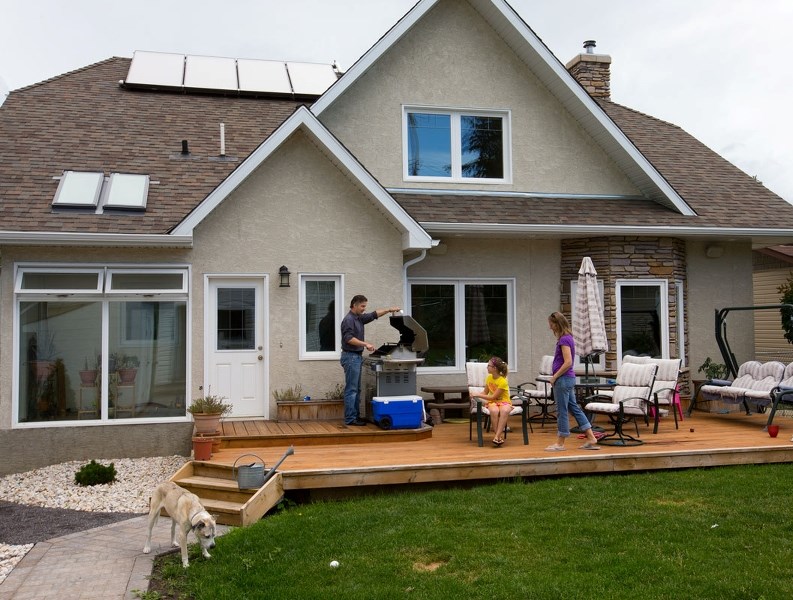When Kelly Gray turns on the tap, she lets the sunshine in. Gray, who lives in an ultra-energy-efficient home in St. Albert along with her husband Rick Winklmeier, recently demonstrated how she gets hot water in the kitchen from the sun.
When Kelly Gray turns on the tap, she lets the sunshine in.
Gray, who lives in an ultra-energy-efficient home in St. Albert along with her husband Rick Winklmeier, recently demonstrated how she gets hot water in the kitchen from the sun.
“You turn on the tap and it comes out,” she said.
The heat comes from a solar thermal energy system installed on the roof and in the basement, Winklmeier explained. Panels on the roof capture heat from the sun to power their hot water tank and in-floor heating.
“We wanted to pick a method that could get us closest to off the grid with the closest return on investment,” Winklmeier said of their choice to go solar thermal four years ago. Their research convinced them to go this route.
The system, combined with the home's other features, means that their home uses about half as much natural gas as a regular home for space and water heating, he says.
“During the summer from basically May to September we just turn our boiler off. We don't use any gas at all.”
That means guilt-free hot showers, Gray added.
“You don't feel guilty because you're not using all that natural gas.”
Solar heating
Leigh Bond of St. Albert's Threshold Energies Corp. has worked with solar thermal systems for about 12 years, and helped install the giant 64-panel one that now provides about half of the hot water for the bathrooms at the Edmonton International Airport.
Water heating accounts for about 17 per cent of a home's energy use, reports Natural Resources Canada (NRCAN).
Bond says that's about 27 gigajoules of natural gas or 7,600 kilowatt-hours of electricity a year, which results in about 3.5 or 5.6 tonnes of greenhouse gas emissions per year, respectively.
A typical $9,800 solar thermal system can eliminate about 70 per cent of these emissions, saving you about $450 a year (assuming you use natural gas) and shaving about 2.6 tonnes off your carbon footprint, he estimates.
The systems themselves are pretty simple, Bond said.
“The only moving part in them is the pump.”
Much like a radiator, tubes on a home's roof capture the sun's heat and transfer it to water in your hot water tank.
Flat panel systems feature tubes full of glycol and are often mistaken for solar electric panels. Evacuated tube systems use exposed vacuum tubes with a strip of copper in them that heat a tube full of glycol. Tests conducted by NRCAN suggest flat panel ones are a bit better, as they're enclosed which lets the snow slide off of them, Bond said.
A pump moves the glycol into the house to heat a large, heavily insulated hot water tank. When the tank is up to temperature, the pump shuts off.
The solar thermal collectors get hot fast, Bond continues – up to 190 C in some cases.
“Even when it's 40 below outside, these systems can generate 150 C water.”
Good, but not best
Solar thermal systems have disadvantages.
They have to be mounted on a south-facing roof at a 53-degree angle for best results in Edmonton, which some homeowners might not like, Bond says. They also have to be supplemented by a gas or electric boiler during cloudy weeks and low-sun months like January and February.
Solar thermal is also a lot more expensive than solar electric heating nowadays, said David Vonesch, an engineer with Calgary's SkyFire Energy Systems. Whereas the price of solar electric panels has plummeted in recent years, the price of thermal panels has climbed due to the cost of materials such as copper.
An $8,700 solar electric system can now produce the same amount of energy as a $9,000 solar thermal one, he estimates. You'll also be offsetting electricity, which is four to four to five times more expensive and much more carbon-intense than gas.
The solar thermal system will cost about $200 every three years for maintenance, as you have to replace the glycol and pumps, Vonesch added. Solar electric ones typically require no maintenance – there's no fluids to replace or leaky pipes to fix – and often come with much longer warrantees.
Vonesch says his company stopped selling solar thermal systems three years ago due to these issues. It's a solid technology, but the finances no longer make sense.
If you've got the roof space, Bond said you should definitely go for solar electric to heat your water. But if you don't, or you need a whole lot of water (like a car wash), solar thermal is your best bet.
“It's a niche market.”
Carbon Tracker
Step:
Difficulty: Tough.
Cost: About $9,800.
Payback Period: About 22 years (at $450 in savings per year).
Carbon Saved: 2.6 tonnes per year.
The Carbon Challenge
Climate change is happening, and it's being driven in most part due to our carbon emissions. Our carbon challenge is to reduce those emissions so that the climate of tomorrow is better than the one we have today. <br />The Carbon Challenge will profile different ways you can shrink your carbon footprint and (usually) save money every second week. <br />Got a carbon question? Drop me a line at [email protected].




